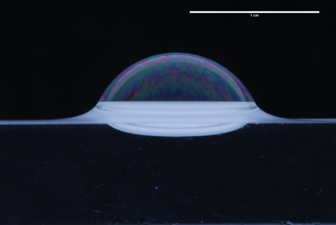Most research in bubble mechanics is done using soap bubbles. This is due to the easy access to the materials
necessary to make them as well as the manageable scale on which they exist. These bubbles consist of a soap
dissolved into water, sometimes with added metal salts, to create a soap-water solution. When the bubble is
not immersed in water, it is encapsulated by a thin film of the solution, whose high
surface tension allows the surface to stay intact.
Thin films are generally separated into two
categories: dry films and wet films. Dry films have very little liquid between the interfaces of the films that
contain the bubble, and thus less surface flow inside the bubble. This makes it rather easy to make the
approximation that the films represent planes.
Wet films are more difficult to measure and simulate. This is because they contain fluid flow and other
effects caused by liquids. The most important and difficult aspect of this to handle is the capillary rise
of the liquid around the bubble, or the meniscus. This relies entirely on the surface tension of the liquid
that tries to flatten the top surface of the bubble.
Laplace Pressure
The Laplace pressure as defined by the Young-Laplace Equation,
is the difference in pressure between the inside and outside of a surface interface. It is defined as
$$\Delta p = \gamma \left( \frac{1}{r_1} + \frac{1}{r_2}\right)$$
Where r1 and r2 are the two radii used to define the curvature of a two-dimensional
surface, and γ is the surface tension of the film. If r1 and r2 are the same,
as would be the case in a sphere-like section of the bubble, this reduces to
$$\Delta p = \frac{2 \gamma}{r}$$
 Bubble Physics
Bubble Physics